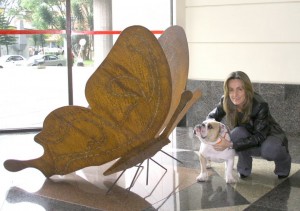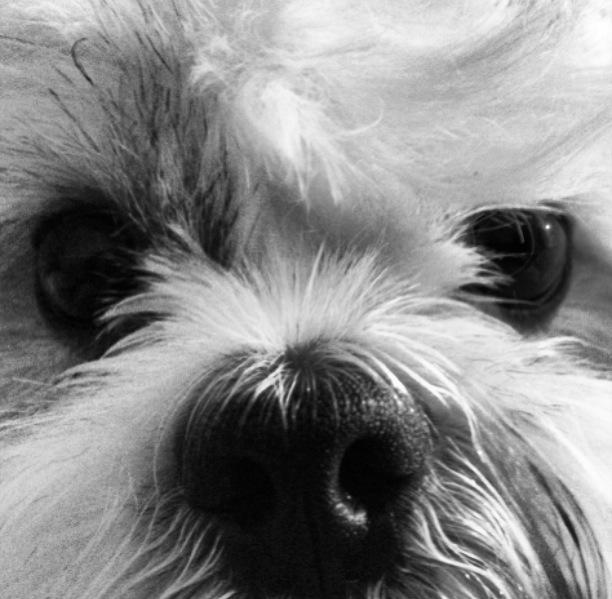Posted October 12, 2013
By KARLA DURANGO
When Maria Fernanda Villamarin went on vacation and traveled from Bogotá to Cartagena just last year, she sent her 8-year-old English bulldog, Otto, in a custom-made kennel in the cargo hold of the airplane. Looking to have a relaxing getaway in the Colombian coast with her canine companion, the trip suddenly took an unexpected and fatal turn.

Otto is seen here with his owner Maria Fernanda Villamarin. He would go to work with her everyday (Photo Courtesy of Maria Fernanda Villamarin).
When Otto arrived in Cartagena, after flying for just over an hour, he was covered in vomit and saliva, according to Villamarin. He could hardly breathe or open his eyes, was unresponsive and seemingly unconscious, she said.
“I was devastated because when he arrived, he was barely breathing and in such poor condition that one moment later he was gone,” she said.
From May 2005 to July 2013, 247 animals were reported to have died on commercial flights and of those, 199 were dogs.
The situation gets more unfortunate, however, as The New York Times reported back in 2011 that more than half of those canine fatalities were among brachycephalic breeds, otherwise known as our cute, flat-faced pooches.
Precisely, dogs like Otto.
These reports surfaced after the U.S. Department of Transportation, in 2005, began to require all U.S. airlines that run scheduled passenger flights to formulate monthly reports whenever pet fatalities, injuries or losses occur during transit and the reports illustrated a tough reality to face.
These days therefore, the growing tendency among commercial airliners is towards a definitive ban on snub-nosed breeds; Delta and American Airlines have outright banned brachycephalic breeds from been sent as checked baggage on commercial flights and others carriers like United and Continental have enacted restrictions on when certain breeds can fly. Usually, the trend is towards an absolute prohibition during the summer months when temperatures run too high.
Snub-nosed breeds, which include French and English bulldogs, boxers, pugs, l’hasa apsos and shih tzus for example, suffer from abnormal breathing patterns because of their short snouts, said Dr. Kate Marmesh, a local veterinarian at the Coconut Grove Animal Clinic in Coral Gables that she has long operated with her father.
“When these animals are stressed or even when they get too excited, often you can observe them having short attacks, something we call the reverse sneeze,” she said. “If you’re present, you can help calm them down, but while in the cargo holds of planes, the problem is that you aren’t there to check on them or help them take full breaths again.”

Brachycephalic breeds are missing the latest biological ingredient required to be able to travel on a plane: a snout (Photo by Karla Durango).
The growing “no-fly” lists however, have also led many to question whether dogs should fly at all.
“All dogs are at risk,” Marmesh pointed out. “When I am performing the physical exams required for traveling, one thing I always make sure people keep in mind is if the trip is absolutely worth it.”
While most animals under 20 pounds are still allowed to fly in the passenger cabins of most aircrafts, there are only a few airliners today, such as Alaska Airlines and Hawaiian Airlines, that allow snub-nosed breeds to fly in the cargo holds of their planes.
Large dogs and those not pertaining to the brachycephalic category, enjoy lesser travel restrictions and are still allowed to be checked or sent as cargo.
Considering the not-so-positive facts previously presented, however, you may not even want to toy with that last option, regardless of the breed.
As Villamarin learned from her tragic experience with Otto, traveling with your pet may paint out to be a rewarding experience, but it is important to weigh the potential risks and consequences the trip may have on your pet; while most of the time everything goes smoothly and everyone arrives safely, from time to time, your animal may not be so fortunate.
“Now, I would rather drive for five days then take on the risk of sending my dog on a plane,” she said.
So what are pet owners to do if they absolutely must travel with their dogs?
The fact of the matter is that there is no simple alternative to flying, but driving and doggy airlines for national and international travel are among alternatives that exist.
“The problem is that many people don’t have the time or the option to drive, depending on their destination, and others don’t have the financial capacity to invest in sending their pet on a private pet airline, which is also something very new and still widely unexplored,” said Villamarin.
For larger and non-brachycephalic breeds still allowed on commercial flights as checked baggage, the common practice among veterinarians is to also warn people to take precaution and follow any instructions given to the tee.
“Preparing your pet for a long flight is much like preparing your pet for surgery,” emphasized Marmesh. “It is that important,” she emphasized.
Luckily, airlines like American, Delta and Continental have also set out to improve their pet programs over the last few years, after the shocking reports by the U.S. Department of Transportation implored them to do so. Subsequently, they now provide greater safety tips and ensure higher-quality service and staff to make your pet’s journey as safe as possible.
Fortunately for most bulldogs and their flat-faced brothers and sisters however, they no longer need to go through the trouble or the risk of flying, as they are definitively no longer welcome on most airlines today.
If You and Your Dog Go
Websites to Visit
- Pet Airways: http://dev.petairways.quimbik.com/
“Pet Policy Restrictions”
- American Airlines http://www.aa.com/i18n/travelInformation/specialAssistance/travelingWithPets.jsp
- Delta Airlines http://www.delta.com/content/www/en_US/traveling-with-us/special-travel-needs/pets/pet-requirements-restrictions.html
- United Airlines http://www.united.com/web/en-us/content/travel/animals/default.aspx
Informational Links on Pet Travel
- http://www.peta.org/ – People for the Ethical Treatment of Animals
- DogFriendly.com – provides information and useful links to dog-friendly lodging, parks, and beaches.
- TakeYourPet.com – requires a membership but offers a free monthly electronic newsletter that provides updates on pet-friendly lodgings and airlines.
Coconut Grove Animal Clinic
- Address: 3200 Grand Ave., Miami, Fla. 33133
- Phone number: 305-448-2123
- Hours of operation: Open Monday through Saturday for walk-in clients from 9 a.m. to 12 p.m. and from 2 p.m. to 5 p.m. They work on a first come, first served basis with the following exceptions: Surgery, dental work or boarding.
